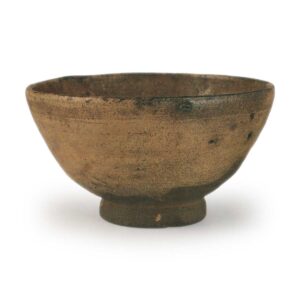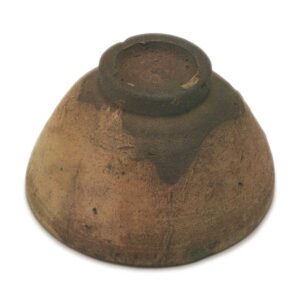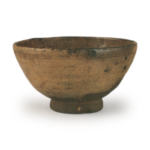

Height: 7.8cm
Diameter: 13.8-14.1cm
Height of foot ring: 6.1cm
Height of rim: 1.4-1.5cm
Even among the famous Okukoma tea bowls of the Koan, Nakao, and Shozo-in schools, this tea bowl is highly regarded for its deep flavor, and it is thought that the name “Fukayama-ji” was given in reference to the fact that it is an Okukoma tea bowl and the wabi-like atmosphere of its workmanship.
Korekan, Nakao, Shozo-in, and Fukan-ji are all referred to as Okukoma, but each has its own unique clay taste. The shapes are different, and it can be seen that the kilns are not all from the same place. However, all of them are considered to be of the old Karatsu style, and it can be seen that the name Okukoma is also based on the assumption that it is an old Karatsu style.
The greatest strength of the Fukan-ji ware is its subdued coloration and the softness of the glaze, which is something that no other Okukourai ware can match. The fact that the rim is so deeply and boldly carved from the waist to the rim is one of the distinctive features of this tea bowl.
As usual, the foot ring is made in the distinctive Karatsu style of thin, flat clay, and the inside of the foot ring is rounded off, with the exact shape of the inside of the helmet remaining. From the foot ring to the rim, the bowl rises up in a full, round shape, but the body tapers off slightly, and the rim is slightly turned inwards.
The inside is large and deep, and it is very full, with a perfect spread for a Japanese thick tea bowl. Moreover, the overall feel is relatively thin, so it feels lighter than you might expect.
The entire surface, excluding the foot ring and the foot ring sides, is covered in glaze, and while the two sides are a strong yellowish loquat color, the other side is tinged with a yellowish-brown color, but the glaze on the exterior is generally thin, and therefore the craquelure is almost unnoticeably fine. In addition, the glaze is unusually soft for Karatsu ware, and has a similar feel to the fried-tofu-like glaze of Kiseido ware. The glaze on the inside of the bowl is particularly exquisite.
There are four marks on the inside of the bowl, and a small hood appears in the center. There are also small stone-like marks on the inside and outside, as well as small and large holes.
The clay of the foot ring is finely textured and also soft, and the inside of the foot ring shows fine creases. The part where the glaze is broken around the waist also has a natural glaze that has dripped, giving it a rough, simple appearance, and there are two places where the foot ring is attached with tatami mats and where the glaze has broken.
There are two noticeable cracks on the outside and five faint cracks on the inside.
On the inside of the lid of the box, the inscription “Fukayama-ji” is written in black ink, but the author of the inscription is unknown. It is said to be the work of Matsudaira Fumai, but it is difficult to be certain, and even the Taisho Meiki Kan (A Guide to Famous Vessels of the Taisho Period) states that the author of the inscription is unknown.
The origin of the brush in ancient times is unknown, but it was in the possession of the Kyoto Mitsui family, and in the Kansei era it came into the possession of Lord Matsudaira Fumai. It is mentioned in the “Unshu Kakomoku Ki” (A Record of Various Objects from Unshu) as a famous item, and is referred to as “Okukora Fumiyama Miyako Mitsui Kansei Fushimiya Yaiki”. Fushimiya refers to the tool dealer Fushimiya Jinemon, who was a regular customer of Lord Fumai.








